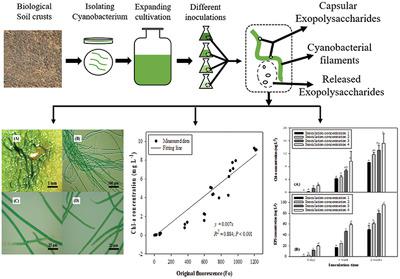当前位置:
X-MOL 学术
›
Biotechnol. Appl. Bioc.
›
论文详情
Our official English website, www.x-mol.net, welcomes your
feedback! (Note: you will need to create a separate account there.)
Inoculation concentration modulating the secretion and accumulation pattern of exopolysaccharides in desert cyanobacterium Microcoleus vaginatus
Biotechnology and Applied Biochemistry ( IF 3.2 ) Pub Date : 2020-04-26 , DOI: 10.1002/bab.1930 Long Qian 1 , Li Wu 1 , Lie Yang 1 , Zulin Zhang 1, 2
Biotechnology and Applied Biochemistry ( IF 3.2 ) Pub Date : 2020-04-26 , DOI: 10.1002/bab.1930 Long Qian 1 , Li Wu 1 , Lie Yang 1 , Zulin Zhang 1, 2
Affiliation

|
Cyanobacterial exopolysaccharides (EPS) accumulated during microalgal cultivation have significant application potential in antioxidation, pharmaceutical products, and so on. Inoculation concentration strongly affects the cultivation cost, biomass, and EPS accumulation. In this study, a high‐EPS‐excreted desert cyanobacterium Microcoleus vaginatus was isolated, and the effects of inoculation concentration on biomass, photosynthetic activity, and EPS accumulation were explored. The results showed that the original fluorescence (Fo) provided a good indication to cyanobacterial biomass, when Chl‐a concentration was lower than 10 mg L−1. Inoculation concentration significantly affected cyanobacterial biomass and EPS concentration (P < 0.001), whereas did not affect photosynthetic activity (Fv/Fm; P > 0.05). The two fractions of EPS, capsular exopolysaccharides (CPS) and released exopolysaccharides (RPS) were strongly affect by inoculation concentration. Other than forming thick sheath (CPS) surrounded the filaments, M. vaginatus excreted higher proportions of RPS to culture medium, and the ratio of RPS to CPS ranged from 1.08 to 1.58 depending on the inoculation concentration. Additionally, although the biomass and EPS accumulation increased with inoculation concentration, the increasing inoculation concentration did not bring to the proportionate increase of the final biomass and EPS yield. Altogether, comprehensively considering the EPS yield and productivity, inoculation concentration of 0.04 mg Chl‐a L−1 is recommended for M. vaginatus to produce EPS, with an EPS yield of 94.32 mg L−1 and EPS productivity of 184.86 mg (mg Chl‐a)−1 L−1 d−1 at the end of experiment.
中文翻译:

接种浓度调节沙漠蓝藻微囊藻胞外多糖的分泌和积累模式
微藻培养过程中积累的蓝细菌胞外多糖(EPS)在抗氧化,药物产品等方面具有重要的应用潜力。接种浓度强烈影响种植成本,生物量和EPS积累。在这项研究中,分离出高分泌EPS的沙漠蓝细菌微球藻,并研究了接种浓度对生物量,光合活性和EPS积累的影响。结果表明,当Chl-a浓度低于10 mg L -1时,原始荧光(F o)为蓝藻生物质提供了很好的指示。接种浓度显着影响蓝藻生物量和EPS浓度(P <0.001),但不影响光合活性(F v / F m;P > 0.05)。接种浓度强烈影响EPS的两个部分:荚膜胞外多糖(CPS)和释放的胞外多糖(RPS)。除了形成围绕细丝的厚护套(CPS)之外,M。阴道RPS与培养基的排泄比例更高,取决于接种浓度,RPS与CPS的比例介于1.08至1.58之间。此外,尽管生物量和EPS的积累随接种浓度的增加而增加,但接种浓度的增加并未使最终生物量和EPS的产量成比例地增加。总之,综合考虑EPS收率和生产率,为0.04mg叶绿素A L接种浓度-1推荐用于M. vaginatus以产生EPS,与EPS得到的94.32毫克的L -1和184.86毫克EPS生产率(毫克叶绿素‐a)-1 L -1 d -1在实验结束时。
更新日期:2020-04-26
中文翻译:

接种浓度调节沙漠蓝藻微囊藻胞外多糖的分泌和积累模式
微藻培养过程中积累的蓝细菌胞外多糖(EPS)在抗氧化,药物产品等方面具有重要的应用潜力。接种浓度强烈影响种植成本,生物量和EPS积累。在这项研究中,分离出高分泌EPS的沙漠蓝细菌微球藻,并研究了接种浓度对生物量,光合活性和EPS积累的影响。结果表明,当Chl-a浓度低于10 mg L -1时,原始荧光(F o)为蓝藻生物质提供了很好的指示。接种浓度显着影响蓝藻生物量和EPS浓度(P <0.001),但不影响光合活性(F v / F m;P > 0.05)。接种浓度强烈影响EPS的两个部分:荚膜胞外多糖(CPS)和释放的胞外多糖(RPS)。除了形成围绕细丝的厚护套(CPS)之外,M。阴道RPS与培养基的排泄比例更高,取决于接种浓度,RPS与CPS的比例介于1.08至1.58之间。此外,尽管生物量和EPS的积累随接种浓度的增加而增加,但接种浓度的增加并未使最终生物量和EPS的产量成比例地增加。总之,综合考虑EPS收率和生产率,为0.04mg叶绿素A L接种浓度-1推荐用于M. vaginatus以产生EPS,与EPS得到的94.32毫克的L -1和184.86毫克EPS生产率(毫克叶绿素‐a)-1 L -1 d -1在实验结束时。











































 京公网安备 11010802027423号
京公网安备 11010802027423号